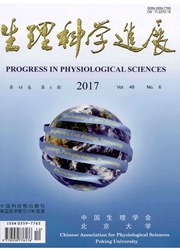

 中文摘要:
中文摘要:
脂蛋白脂酶(lipoprotein lipase,LPL)通过水解血浆中富含甘油三酯(triglyceride,TG)的脂蛋白,为心肌组织提供游离脂肪酸(free fatty acid,FFA)供能.糖尿病期间,由于心肌组织减弱对葡萄糖的利用能力,导致心脏供能不足.此时,机体通过一系列机制上调心肌LPL活性,促进血浆极低密度脂蛋白(very low density lipoprotein,VLDL)和乳糜微粒(chylomicrons,CM)的水解,以增强FFA为心肌组织代偿性供能.糖尿病患者通过上调心肌LPL活性,进而促使血浆FFA浓度显著升高,导致大量活性氧、脂质等在心肌细胞内蓄积,并潜在地诱发糖尿病心肌病(diabetic cardiomyopathy,DCM).因此,本文主要针对糖尿病对心肌LPL的调控机制及LPL如何潜在地诱发DCM做一综述,以期为DCM提供新的治疗靶点和途径.
 英文摘要:
英文摘要:
Lipoprotein lipase (LPL) hydrolyzes plasma triglyceride-rich lipoproteins into free fatty acids (FFA) to provide energy for cardiac tissue. During diabetes, cardiac energy supply is insufficient due to defected utilization of glucose. As a compensation of cardiac energy supply, FFAs are released through the hydrolysis of very low density lipoprotein (VLDL) and chylomicrons (CM) due to activation of LPL activity. In diabetic patients, activated LPL activity and elevated FFAs result in the intracellular accumu- lation of reactive oxygen species and lipids in myoeardium and potentially induce the diabetic cardiomyop- athy (DCM). The present review summarizes the regulatory mechanisms of myocardial LPL and the path- ogenesis of DCM induced by LPL and provides novel therapeutic targets and pathways for DCM.
 同期刊论文项目
同期刊论文项目
 同项目期刊论文
同项目期刊论文
 Inflammation, lipid metabolism dysfunction, and hypertension: Active research fields in atherosclero
Inflammation, lipid metabolism dysfunction, and hypertension: Active research fields in atherosclero Interleukin-18 and Interleukin-12 Together Downregulate ATP-Binding Cassette Transporter A1 Expressi
Interleukin-18 and Interleukin-12 Together Downregulate ATP-Binding Cassette Transporter A1 Expressi Tristetraprolin-dependent Post-transcriptional Regulation of Inflammatory Cytokine mRNA Expression b
Tristetraprolin-dependent Post-transcriptional Regulation of Inflammatory Cytokine mRNA Expression b PAPP-A negatively regulates ABCA1, ABCG1 and SR-B1 expression by inhibiting LXR alpha through the IG
PAPP-A negatively regulates ABCA1, ABCG1 and SR-B1 expression by inhibiting LXR alpha through the IG Epigallocatechin-3-gallate prevents TNF-alpha-induced NF-kappa B activation thereby upregulating ABC
Epigallocatechin-3-gallate prevents TNF-alpha-induced NF-kappa B activation thereby upregulating ABC AOPPs Inhibits Cholesterol Efflux by Down-regulating ABCA1 Expression in a JAK/STAT Signaling Pathwa
AOPPs Inhibits Cholesterol Efflux by Down-regulating ABCA1 Expression in a JAK/STAT Signaling Pathwa Apolipoprotein A-I inhibits LPS-induced atherosclerosis in ApoE(-/-) mice possibly via activated STA
Apolipoprotein A-I inhibits LPS-induced atherosclerosis in ApoE(-/-) mice possibly via activated STA Tertiary-Butylhydroquinone Upregulates Expression of ATP-Binding Cassette Transporter A1 via Nuclear
Tertiary-Butylhydroquinone Upregulates Expression of ATP-Binding Cassette Transporter A1 via Nuclear The Interaction of ApoA-I and ABCA1 Triggers Signal Transduction Pathways to Mediate Efflux of Cellu
The Interaction of ApoA-I and ABCA1 Triggers Signal Transduction Pathways to Mediate Efflux of Cellu MicroRNA-19b promotes macrophage cholesterol accumulation and aortic atherosclerosis by targeting AT
MicroRNA-19b promotes macrophage cholesterol accumulation and aortic atherosclerosis by targeting AT Growth differentiation factor-15 induces expression of ATP-binding cassette transporter A1 through P
Growth differentiation factor-15 induces expression of ATP-binding cassette transporter A1 through P 期刊信息
期刊信息
